Those of you who frequented The Catholic Bibles Blog know that one of the recurring themes/questions I would propose was whether it was more important to use a particular bible translation or to have a bible edition that was readable, durable, and met the needs of the particular Catholic reader. Early on, I would have been firmly rooted in the former camp. Translation was king for me, although if you were to ask me which one was best, I would have likely given a different answer depending on what I was reading at the time. Over time, I must admit that I came to see the good in pretty much every translation. I realized that most of the modern Catholic/Ecumenical translations had far more in common than I had realized or was willing to admit. In the places where there were significant differences, investigating and reflecting on why the translators went with a different rendering has helped me to come to a greater appreciation of their jobs as translators, as well as the great difficulty in translating a text for a modern audience. It isn’t simply that “literal” is always better. I should point to Ronald Knox’s On Englishing the Bible and reading Eugene Peterson concerning his translating The Message as being instrumental in evolving my views (which I still hold today) on Bible translation. (I’ll try to develop and articulate that for a future article.)
While I was in the midst of reassessing my own view on Bible translation, something else was stirring in me. It was strangely tied to my desire for a premium Catholic Bible edition, yet it went off into a different direction. One of the earliest posts on my blog decried the lack of premium Catholic Bible editions, something which is still an issue. {For many, the only real avenue to getting a premium Catholic edition is through sending one off to a book re-bindery for an upgrade. The closest actual premium editions were the ones published by Baronius and the occasional offerings from Oxford. There are, of course, a number of NRSVs w/ Apocrypha that are now available in premium editions (both by Cambridge and Allans), although a purely Catholic edition remains elusive.} Yet, as time went on, my desire (near obsession) for a premium bible began to slowly fade away. Instead, I found myself regularly clinging to a translation (that in the past I would mock) in a format that was the most basic and humble: the dreaded paperback.
So how did I arrive at this place? To be honest, there were a number of things, not at first related, that began to really cause me to reflect on what Bible reading was all about. Almost all of these reasons come from my own lived experience and impacted me in various ways. Having children was the first major experience that shifted my thinking. The same time I was getting a number of bibles rebound in premium leather (the RSV-2CE and Knox specifically) was also when my wife and I were beginning and growing our family. One became two became three in the space of six years. Having children is a great blessing in almost every way, but one way it is not is in their ability to destroy or make a mess of things you have sitting around. In a matter of only a few short minutes, a parent can experience cups or bottles being spilled, dirty diapers being flung around, children spitting up (or worse), and any possible object being knocked off a table or couch. I learned quickly that having a premium Bible out was not the best of ideas. (One of them has a lovely, though small, coffee stain that is noticeable somewhere in the Pastoral Epistles.) Now, I like having a Bible out most of the time in the evenings when I am at home. Part of it is for my own prayer life, other times it is for preparing to teach from it. So the premium bibles got put away or left at work. I was even uncomfortable having any half-decent bible sitting out anymore.
Secondly, and related to the first, my children liked when I would read the Bible around them. They liked it so much that they wanted to contribute to my Bible in very substantial ways. How so? They came to really enjoy adding their own stickers, drawing, bookmarks, crayon creations, etc…. That forced me to seek out a bible that I wouldn’t mind having all those things in and on. Hence, I began looking for a readable paperback Catholic Bible. After I had settled on one, I actually enjoyed having my kids “contribute” to it. “Hey Dad, I got a sticker today of Olaf, can I put this in your Bible?” “Sure, go right ahead.” It was fun at first, but over time it has become even more meaningful. When I open my Bible each day for morning lectio divina I see these contributions from my kids. Each has a story to it, a time and place that are associated with it, a feeling or mood that are evoked from the depths of my being. Among other things, there are coffee stains and a yellow crayon mark that I come upon when praying the Psalms, which cause me not to cringe but to be grateful. I may have mentioned once or twice on my old blog that I greatly admired an older woman I had met at a prayer group years ago who had an original 1966 Jerusalem Bible, which was covered in that really stiff bonded leather. The cover had deteriorated to such a degree that she needed to use two large rubber-bands to keep it together. And she had no intention of ever giving that Bible up. Even though it had seen better days and was quite ugly from an aesthetic point of view, it was beautiful in the amount of love and companionship it had received. I am also reminded of what Pope Francis wrote in the prologue to the YouCat Bible: “You could buy me a new one for $1,000, but I would not want it. I love my old Bible, which has accompanied me half my life. It has been with me in my times of joy and times of tears. It is my most precious treasure. I live out of it, and I wouldn’t give anything in the world for it.” Having used this particular paperback for over three years now, I am on the same path as that woman (and Pope Francis).
Thirdly, having authored a blog where the most popular posts were the ones that reviewed various Bible editions, it should not be surprising that over the course of ten years I came to figure out what I liked and disliked in a Bible. While at first it was all about the cover material and binding, over time I became more interested in page layout. The two things that became paramount for me were a single-column layout along with generous margins for annotations. But as many of you know, there are not many options that fit those two needs. Editions that came immediately to my mind were the Little Rock Catholic Study Bible, the HarperOne NRSV-CE Standard Edition, and the New Jerusalem Bible. Each of them could have worked, but there were certain issues I had with each of those three, from the presence of too many notes, the thinness of paper, to the overall size. There was one other option, however, that fit the need perfectly, but it would be a most unconventional choice.
The final step in my journey was in some ways the most unexpected. I have always been intrigued by the way people get attached to certain Bible translations. It can get a bit crazy at times, most notably when people hold to some form of (insert your favorite translation)-onlyism. While I was influenced by this type of thinking for a number of years, this started to change when I began to read and re-read translations that I had intentionally avoided, for example the NRSV. It was only after I sat with a translation like the NRSV, read a bit about how it came to be, and then prayed with it that I actually came to a greater appreciation of it. (I would say the same thing about the NAB, which is unjustly maligned online by so-called experts who typically recycle the same complaints about a handful of renderings, not to mention most have not even read the revised edition.) To this day, I regularly use the RSV, NRSV, and NABRE for study and teaching. All three of them have their strengths and weaknesses, each being created by scholars who love the Scriptures and took their jobs of translating seriously. But, this story is not how I embraced any of those fine translations, though I very much like, support, and use them for study.
For the past three years or so I have started each day with scripture reading and contemplative prayer. (Currently, I am going through the 19th annotation of the Ignatian Spiritual Exercises, so my my morning routine is a tad bit different, but not completely from what I have been doing.) Typically, that means getting up early, usually around 5AM, in order to have time for silence when the children are still sleeping. Those with three young children know that this is not an easy task. The Bible that has been with me each morning has been a paperback version of ACTA’s The Message: Catholic/Ecumenical Edition. I purchased a fairly cheap Bible cover, inserted three green Bible ribbons, and made my own additions to it, including a separate map section, prayers, images, and meaningful quotes. (I have also been reading through the New Testament and Psalms each year, adding cross-references to the inner-margins as I go.) From the outside, this is not a pretty bible. It compares in no way with the exquisite Cambridge NRSV Reference Bible w/ Apocrypha in goatskin I received last year.
Yet, I adore this Bible like none I have ever owned. And yes, I can hear the complaints (and perhaps snickers) from some who will argue that The Message isn’t a real translation, but a lowly paraphrase. Yes, yes, I am aware of that. NavPress describes the translation style as “contemporary equivalence,” standing between two approaches to translation: paraphrase and “dynamic equivalence.” From my reading of The Message, I think that is a good description of it. I was able to get a review copy of the Catholic/Ecumenical Edition when it was first published in 2013. At first, I did my review for the blog and then put it away for a good year or so. It was only after many of those feelings that I described above began to surface that I gave it a second look. Simply put, it speaks to me on a deep contemplative level. I feel immersed in the story of salvation. The Psalms, which display Peterson’s “contemporary equivalence” style more than any other of the biblical books in The Message, have impacted me in deeply personal and profound ways. When Psalm 40 opens with “I waited and waited and waited for God” and Psalms 130 and 131 commend the reader to “wait and watch” with a “quiet heart” I find myself deeply moved at a time in my life when easy answers won’t work anymore and deeper questions about God and my place in his creation. My only desire is to wait on God with an open and still heart. The Message has been a great help to my waiting, along with the writings of Thomas Merton. I find Eugene Peterson’s Message to be illuminating, awkward, funny, in-your-face direct, occasionally too interpretive, but never boring or distant. It is a perfect match to my morning prayer and coffee, both of which sometimes spill onto the page. It is not for everyone, perhaps even most people will not like its style or purpose. I truly get that. Yet, it has been my companion for the past three plus years, and I don’t see this changing anytime soon.
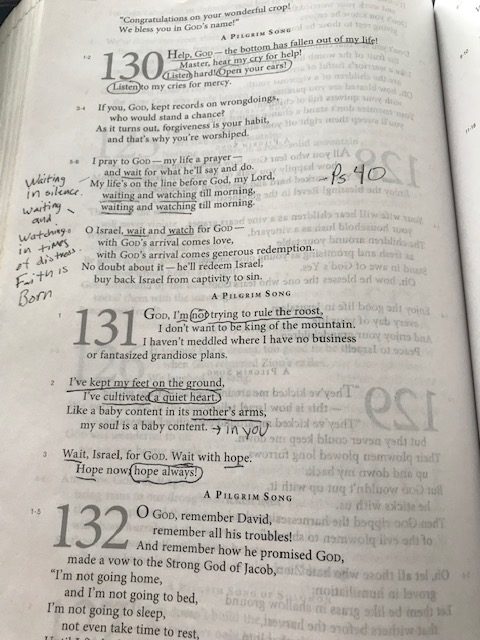
In the end, I have embraced what many would consider an ugly looking Bible containing a unique and odd translation. My wife jokes with me from time to time wondering when I am going to start reading the actual bible again. We laugh. Maybe I will pick up another Bible for daily reading at some point, but I cannot forecast that possibility, just as I couldn’t have predicted where I am at right now. But God has been slowly working on me these past three years. With all the theological education I have been graciously given in the past, and for which I am eternally grateful, it has only been during these past years that I have felt God truly pursuing me. In the past it has been all about me and my seeking after God, only now do I realize that it has been the exact opposite. Leif Peterson, during his eulogy for his father back in November, remarked that his father had only one sermon. It was the truth that: “God loves you. He’s on your side. He’s coming after you. He’s relentless.” My ugly Bible has been a key component in the realization of that truth. A truth that I had backwards for so many years. Just as the idea of something being “ugly” can turn out to be so “beautiful.”
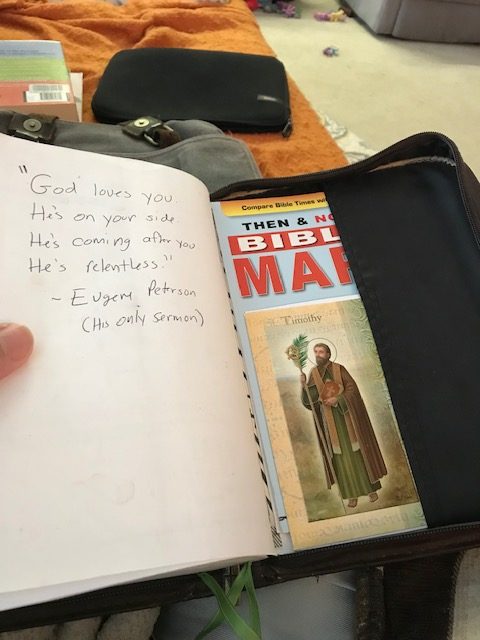
“Confessions of an Ugly-Bible Reader” by Timothy McCormick (C) 2019
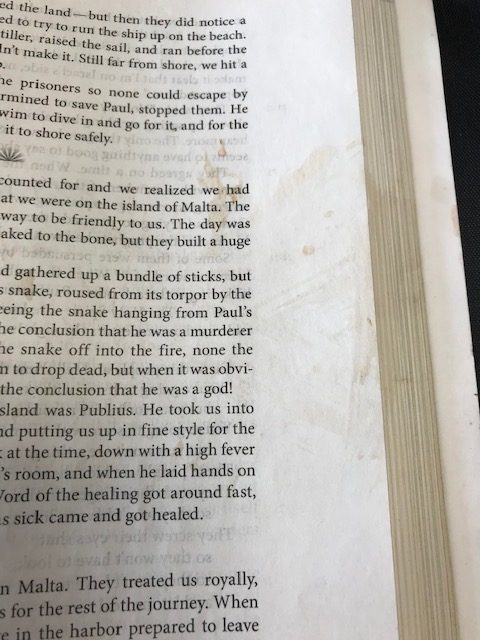
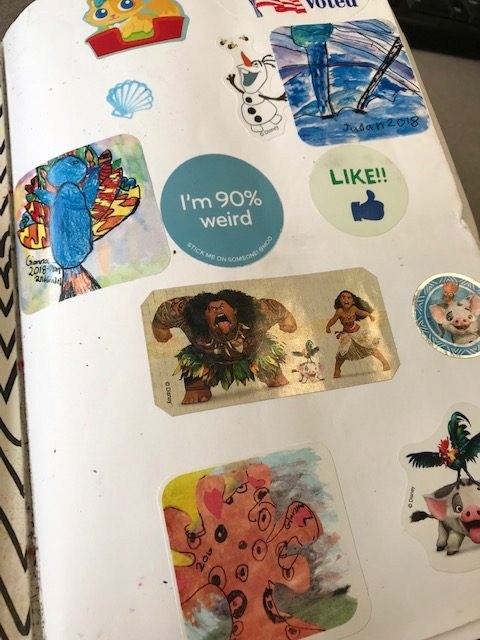
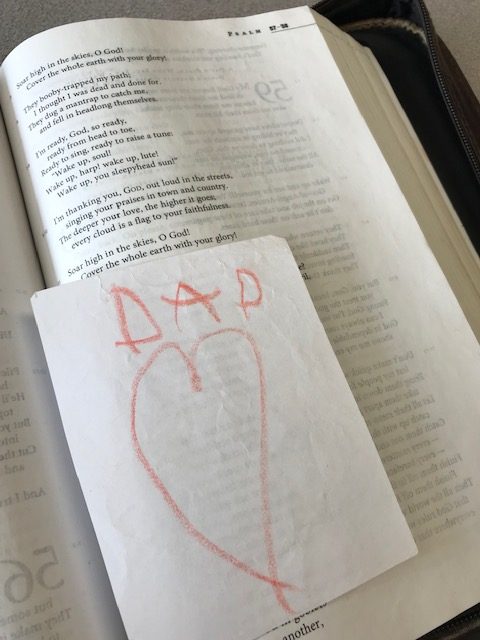
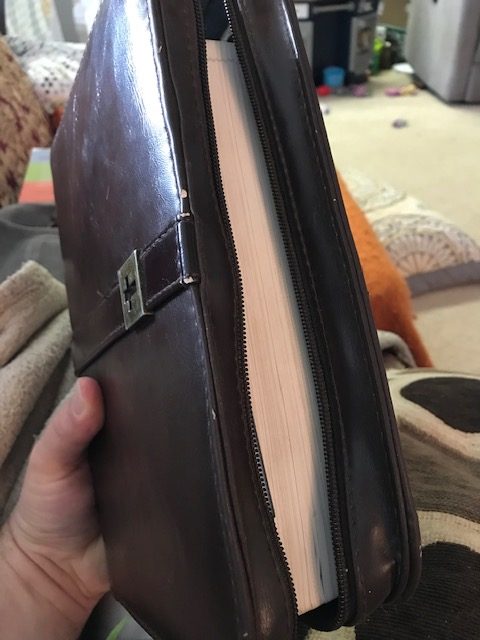
I also have changed my views on the “Premium” Bible. I have little ones at home, and my Bible can’t be a delicate, expensive decoration that no one is allowed to touch. I also have a Bible cover with the “Then and Now” Bible maps, as well as a few other excellent reference pamphlets from Rose. So yeah, it doesn’t have to be a “study” Bible. I still find my Didache indispensable for Bible studies at my parish, but for reading at home and at adoration there are several I can choose from. I don’t have just “one.” I am looking forward to Scepter’s new RSV-CE which should be out any time now, and that one should get a lot of love. It is nice to have a Bible to hold in one hand, especially if you have little kids climbing on you!
Jonny,
Yes; why wait around for something that will never be produced. Make it your own. It has been a revelation.
You’re chipping away at my armor, Timothy. I might have to break down and buy The Message one of these days!
All I can say is that if you do, you will not like it at first. But if you sit with it a while, it will grow on you.
Tim, as a long time reader of “your” blog, a not in frequent commenter and very occasional guest writer and as a friend who has shared in person and now years worth of direct message chats with you, I have to say this is the bestest-best piece. The fruit of much honesty and growth. “Silence is praise to you, Zion-dwelling God, And also obedience. You hear the prayer in it all.” [MSG PS40.1-2; (yes, yes I know you know where that is 😉 ]
It is this kind of love for the revealed/translated word of God that every Christian of any denomination would do well to have for it is this kind of love/respect/intimacy/relationship that produces “the” fruit.
May your honesty so well expressed here find good soil among those who read this post.
Thrive!
Much respect for this Tim! This is the best thing I’ve ever read on your blog or Marc’s.
Congrats on going through the 19th annotation exercises! I pray it bears much fruit.
Peace everybody.
Correcting some voice to text type-o above (because I am OCD enough to think it matters )
1. Infrequent not “in frequent”
2. Psalm 65 not “40”
🙂
This is a lovely and inspirational story about the Bible.
I had some Bibles, but the font was too small that it was hard for me to read for long. Yes, sometimes I just read a few lines, but others I don’t want to leave it down. I started looking for a Bible with big fonts,
After reading the history about the NRSV, I decided to get one. Before receiving it (I ordered online) I started feeling stressed and disappointed when I read comments online that NRSV was a bad translation. Looking for other translations I found the same kind of comments for every single translation, with no exception. So I decided to read any of them, based trusting that God will deliver his message.
After reading your article, I feel peace and confidence on the approach of reading the Bible that inspires me. I think that every translation is translated with the best and good intention of making it understandable. And that is what we should consider as part of our analysis.
There is an old say: The best Bible is the one you read.
Thank you for sharing this article.